Distinguishing Musical Feature(s) (DMF)
The fact that virtually all Chopin first editions were revised at least once during their commercial lifetimes means that close study of the music text – the most essential part of any score – and in particular of the changes made in relation to previous or later impressions must be undertaken if a score is to be reliably identified. Given that such changes are often extremely abundant and thus resist exhaustive description, our approach has been to list under this heading those ‘distinguishing musical features’ that best facilitate identification of a particular score. The following principles have guided our selection:
- A single DMF is specified for self-contained works (i.e. those without movements or
constituent numbers) which were revised only once. The original DMF text –
usually the result of an engraving error or omitted accidental – is described
in the entry for the earliest impression containing it; similarly, we note the
presence of its corrected counterpart in the first impression in which it appears.
- For self-contained works (as defined above) revised on more than one
occasion, a single DMF is indicated for each corrected reprint. Original DMFs are
listed with regard to the earliest relevant impression, while revised versions
thereof are respectively described in connection with the first corrected reprint in which they
appear. In these cases ‘refinement’ occurred
gradually, in step with the successive corrections (some of which were
themselves erroneous and/or reversed previous changes – for example, compare
7–1-W, 7–1a-W and 7–1j-A&P; likewise 32–1-W, 32–1a-W, 32/1–1h-A&P and 32–1k-A&P).
As a result, one must carefully trace through the entire evolution of a given
edition in order to avoid misinterpreting the status of intermediate and later
impressions.
- In more complex cases where corrections were introduced
to the music text (i.e. in the mazurkas, nocturnes, concertos, sonatas and
Polonaises Opp. 26 & 40), a single DMF is specified for each movement or constituent work within a multipartite opus,
whether in the original format or in the separate editions of the latter which
may have been published. A similar approach has been taken for the
chamber pieces (Opp. 3, 8 & 65 and Grand Duo Concertant) for which a
single DMF per instrumental part is cited. This practice does not extend, however,
to the Etudes Op. 10, Etudes Op. 25 and Preludes Op. 28 for which we specify a
more limited range of DMFs because of the large number of constituent pieces
and in order to expedite the identification
process (though without any loss of rigour).
Two or more DMFs are specified in a few instances either because a logical connection exists between them (i.e. 34/2–3-B&H and 34/2–3c-B&H; bs 92–93 of 36–1-W and 36–1a-W; 38–0-TR and 38–1-TR), because a given imperfection affects a similar or identical bar or one close to it (e.g. 1–1-HO and 1–1b-HO; 3–1-ME and 3–1a-ME; 5–1-HO and 5–1a-HO; 7–1-W, 7–1a-W, 7–1i-W and 7–1j-A&P; 20–1-W and 20–1c-W), or because a feature corresponding to the DMF appears in the other hand within the same bar (e.g. 7–4-KI and 7–5-KI; b. 7 of No. 2 in 10/1-6–1-W, 10/1-6–1e-W and 10/1-6–1h-A&P; No. 11 in 10/7-12–1-W and 10/7-12–1b-W; No. 1 in 25–1-Sm and 25–1a-Sm; No. 14 in 28–1-B&H and 28–1h-B&H). Exceptionally, one DMF is used to identify the copies of two different editions whose basic description is identical or very similar; in such cases only, the DMF is specified not in the earliest impression of the edition in which it is found, but in the one most like the subsequent impression with which it risks being confused (9–1c-KI and 9–1d-KI; 66–2a-Sam and 66–3a-Sam; 69–1b-Sam and 69–2-Sam).
The various DMFs have also been selected because they can be easily described and also because they appear near the beginning of a work. It must once again be emphasised that to obtain a precise image of the evolution of a given edition’s music text one must undertake a comparative, detailed analysis of the entire range of original and corrected impressions. Although such an analysis cannot be fully documented within this catalogue, the potential utility of the DMF apparatus should nevertheless be noted.
In the DMF descriptions, accidentals contained within square brackets do not literally appear in the music but are implied by the key signature; the same is true of accidentals in round brackets (parentheses), which are however present earlier in the relevant bar and thus apply to the DMF pitches in question. Pitch register is specified using the Helmholtz system (with superscript arabic numerals rather than primes); where relevant the stated register takes into account a prevailing ottava.
We have numbered individual bars as follows. Incomplete anacrusis bars at the beginning of works are referred to as ‘bar 0’ with two exceptions, i.e. the first bars in Op. 38 and in the third movement of Op. 58. Where repeat signs occur, the bar numbers of first endings appear with the suffix ‘a’, while ‘b’ is attached to bar numbers of second endings (e.g. 69–1-Sam and 69–2a-Sam). Note that the bar numbering is based on the source in question and thus may not correspond to other editions which differ in content or configuration.
We employ a precise and unambiguous means of identifying individual notes and chords within a bar by defining their position in terms of the event therein. Thus, if for example the first right-hand ‘event’ is a single note, followed by an octave and then a three-note chord, these would respectively be identified as RH note 1, RH chord 2 and RH chord 3. (For reasons of economy the term ‘chord’ is also used for dyads.)
The following case study – based on Wessel’s edition of the Nocturne Op. 15 No. 2 – demonstrates how the successive corrected reprints of a given edition can be identified while also illustrating the various notational features described above. The analysis hinges upon three DMFs initially found in bs 6, 20 & 32 of 15–1-W (shown here as extracts without the key signature of six sharps or treble/bass clefs for right and left hands respectively):
15–1-W
b. 6, RH note 2: f[#]2
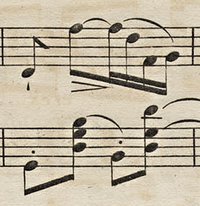
b. 20, LH chord 4: no pedal
release
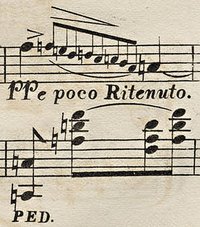
b. 32, RH note 3: a[#]1
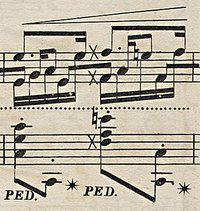
15–1b-W, b. 32
In 15–1b-W, bars 6 & 20 remain as in 15–1-W, whereas RH note 3 in bar 32 becomes b1
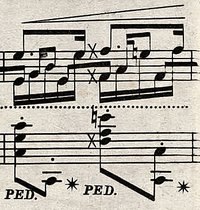
15–1d-W, b. 6
In 15–1d-W, bar 20 conforms to the original version in 15–1-W and bar 32 to the revised version in 15–1b-W, whereas a precautionary =# is added to bar 6, RH note 2:
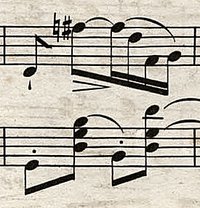
15–1f-A&P, b. 20
In 15–1f-A&P,
bar 6 corresponds to 15–1d-W and bar 32 to 15–1b-W, but
a pedal release (of a different design) is added under bar 20, LH chord 4:
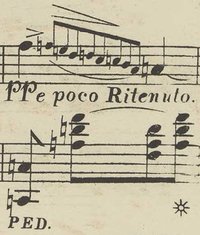
15–1g-A&P, b. 32
Finally, in 15–1g-A&P,
bar 6 appears as in 15–1d-W and bar 20 as in 15–1f-A&P,
but RH note 3 in bar 32 becomes c[#]2:

As this case study reveals, four corrected reprints of Op. 15 published by Wessel and his successors can be accurately identified by referring to the music text of the second Nocturne alone, and only three bars at that. This does not of course obviate the comprehensive, in-depth analysis of the entire opus that is required to gain a complete understanding of how this edition evolved over time. Such an analysis would need to consider not only changes to the music text, but also those to the ITP (15–1a-W), STP (15–1b-W, 15–1c-W, 15–1d-W, 15–1e-W, 15–1f-A&P, 15–1g-A&P), contents (15–1a-W, 15–1f-A&P, 15–1g-A&P), caption title (15–1c-W, 15–1f-A&P), sub-captions (15–1c-W)[1] and footlines (15–1b-W, 15–1c-W, 15–1d-W, 15–1e-W, 15–1f-A&P). This catalogue lays the essential groundwork for an undertaking of precisely this kind while allowing individual users to pursue the requisite investigation themselves.
[1] The introduction of a decorative element in the SCs of 15–1d-W and later reprints has not been described for the reasons outlined in Sub-caption.